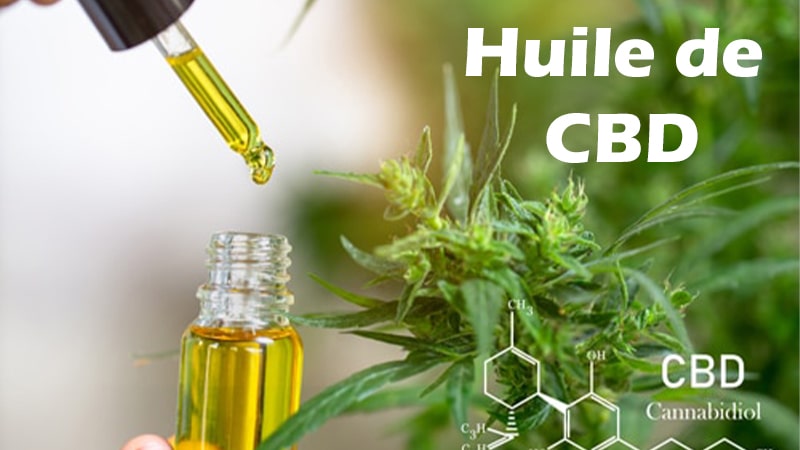Blog la Verte Shop
CBD oil : All about the different oils.
For months now, products based on Cannabidiol (CBD) have been developing at great speed in France and throughout Europe. You can find all types of products such as flowers, resins, food and cosmetic products, but also oils. However, there are several types of oils, and it can be difficult to understand everything. So we will help you to see more clearly.
What exactly is CBD oil? What are the differences between hemp and cannabis? Where does the oil originally come from? We will try to answer all these questions. In addition, the extraction methods to obtain CBD oil, the use of CBD drops will also be discussed. At the same time, we will discuss the effects and possible side effects. Finally, we will briefly present the possible applications of cannabis oils, as well as the correct dosage of these CBD products. CBD.
CBD oil: What is it, and where does it come from?
CBD or cannabidiol is one of more than a hundred cannabinoids found in the cannabis plant. It has been growing exponentially in popularity for the past few years. The users are diverse and varied: mothers, grandparents, hipsters and hippies, etc. CBD oil is currently becoming the remedy of choice for pet owners. They want to ensure that their faithful companions have an anxiety-free and pain-free life.
What is cannabis oil?
Cannabis oil is obtained from hemp plants specially cultivated for their high CBD content. Among these, the Cannabis Sativa La plant with a very low THC content. Therefore, the extraction of the oil does not cause intoxication or psychotropic effects. The CBD content of cannabis oil can vary from product to product. There are several ways to consume it: vaporize the oil and thus absorb the active ingredients through the respiratory tract, add the oil to food or take it orally. The way you consume cannabis oil will depend entirely on your preferences. Cannabis oil is often associated with various positive effects on the mental and physical well-being of humans. However, no official studies have yet been presented on this subject, and we of course recommend that you contact your doctor before taking any CBD oils or other products.
How to obtain CBD oil by extraction?
As with peanut oil, for example, there are different types: hot extracted or cold pressed, refined or not, etc... The same principle applies to CBD oils. It all starts with the extraction of the oil, and to do this, there are 2 types of extraction:
- Extraction with CO2: In this process, the biomass (plant material) is filtered through a series of chambers to isolate the different cannabinoids and terpenes at different temperatures (all of which are controlled using CO2, hence the name of this method). They are then literally squeezed out of the plant with high pressure. This is, to this day, the most widely used extraction method because it allows the isolation and removal of unwanted components in the plant without leaving any residue.
- Solvent extraction: This process is clearly less expensive than the previous one. It consists in injecting a solvent (ethanol most of the time) in the hemp plant. This solvent dissolves the cannabinoids in order to extract them from the plant. The mixture is then subjected to evaporation, which leaves only the plant's compounds.
The production of the oil following the extraction
Once the crude hemp oil is extracted, the product must be packaged for consumers. This is a winterisation and/or insulation process. The process used is determined by the type of final product desired.
- Full spectrum CBD oil: Winterization removes waxes and other impurities. What remains is broad spectrum or full spectrum CBD oil. This contains a wide range of cannabinoid acids (decarboxylated cannabinoid precursors) / cannabinoids (carboxylated cannabinoid acids) such as THC and Cannabidiol, terpenes and flavonoids.
- Cannabinoid isolates: the crude hemp oil is subjected to a process called centrifugal partition chromatography (CPC) in which all other components are removed, leaving pure Cannabidiol at about 99 % or other cannabinoid isolates.
The effects and benefits of using CBD oil
We remind you that this passage is for information purposes only, and that in no case do we invite you to consume them. Once again, it is imperative that you consult your doctor before using these products.
The scientific community agrees that CBD has analgesic properties. It helps to reduce pain and inflammation by controlling and suppressing the α3-glycine receptors that cause the sensation of pain. CBD can also have an immunosuppressive effect, which helps reduce inflammation and pain.
It can also help treat certain cancers by killing certain cancer cells and reducing the size of tumors by regulating the expression of the Id-1 gene.
Regarding anxiety and depression, CBD stimulates serotonin levels in the brain, and selective serotonin reuptake inhibitors (SSRIs). It also appears to stimulate neurogenesis in the hippocampus, the part of the brain that regulates emotions and mood. Thus, CBD could help calm anxiety and stress as well as make depressive periods more bearable. In the same sense, CBD oil could help you fight insomnia and make you sleep better.
How many drops and how to consume them?
Although we don't have clear and safe data on the dosage of the oil yet, the medical community, experienced users and empirical experience suggest that it is best to "start small and work your way up". This generally means starting with 25 mg of CBD twice a day, and then gradually increasing this dose by adding 25 mg every 3 to 4 weeks until the expected effects are achieved.
Are there any side effects?
Being a product considered non-narcotic, there is no evidence of harm to the human body. However, users may react differently to the effects of CBD. Some of the known side effects can be: dry mouth, mild drowsiness, dizziness, and diarrhea. It is therefore important to talk to a doctor before using it.

